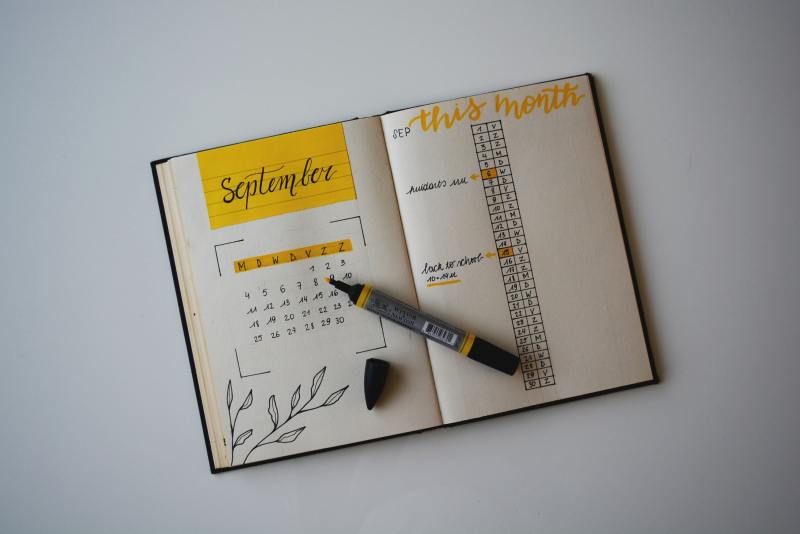Pretty highlighters, stickers, and fountain pens — this is the foundation of the bullet journal trend that took over social media feeds within the past few years. Bullet journaling is often portrayed as a way to increase artistic expression in a planner. Monthly calendars get adorned with doodles and trackers for mood, sleep, and more, all meant to be used as a creative approach toward reflection and growth. Youtuber AmandaRachLee has gained millions of views from her bullet journal updates. Studyquill’s bullet journal journey amassed an audience of hundreds of thousands of people. These are only a few of the many channels that helped popularize this trend, placing dotted journals into average households. Despite bullet journal’s original intentions, its community’s social media presence has enforced unrealistic standards.
Although one’s planning system is supposed to be unique to themselves, I’ve seen the productivity community mainly promote the most perfect, embellished spreads. This creates the pressure to consistently match such spreads, which can be unrealistic and exhausting. The demand for an “aesthetically pleasing” journal risks the functionality of journaling and stigmatizes making mistakes.
Prior to bullet journaling, I was scrapbooking to capture moments on field trips and hangouts. I was excited to create something I could look back on, something that would hold various memories of my life. Still, a year later, I wanted to try bullet journaling to increase my productivity through planning and I enjoyed the artistic part of bullet journals.
I pulled up inspiration and fell deeply into the BUJO rabbit hole. Some of my friends started sending me their monthly spreads, which were clean and covered with beautiful doodles. I remember spending hours on the cover pages only to be dissatisfied with many of them. Why couldn’t they look like the ones online? Every time I created something I didn’t feel would meet the standard for a “pretty” bullet journal, I would be turned away from even utilizing the spread.
I also realized mood trackers were too vague for me – they could never truly capture my mood. I wanted something to glance back at and estimate how the month felt, but clusters of colored squares couldn’t effectively communicate my emotions. My days would often consist of more than one mood, forcing me to cram multiple colors in a single box. It was difficult to express details with a tracker.
Practically every bullet journal from Pinterest to Instagram is littered with clean-cut doodles, which connects to the artistic portion of bullet journaling. Pictures from social media of extremely glamorized spreads reinforce the standard of only creating the most perfect art. When these posts also gain the most traction and recognition, it perpetuates an ideology for an “acceptable” bullet journal.
My friend described how they felt restricted due to the size of a bullet journal setup and the pressure of having it be “Instagrammable.” Instagram and other social platforms push people to paint themselves in their most marketable, likable light. This is why a lot of bullet journals refrain from giving too many details about a day. Bullet journaling doesn’t allow much honest reflection for a supposedly expressive hobby.
Artistic experimentation and improvement often get hindered by a constant stretch for perfection. When my bullet journals didn’t align with aesthetic ones online, I felt this pressure for perfection and only drew the few doodles I knew I could make look nice, leading to less experimentation and less artistic improvement.
An Alternative – Digital Planning and Creative Journaling
I prefer looking back at my old journals over flipping through bullet journals. My free-form journals felt more personal, authentic, and natural.
For people drawn to bullet journals for the artistic aspect, I’d recommend art journaling. Art journals allow people to release more genuine emotions and experiment with various mediums. These can also reveal a lot about a person. If having a customizable planner is the goal, I’d propose using digital planning services such as Notion. Around the middle of last year, I discovered the app and began to plan all my assignments, reading lists, and more. Though some people focus on aestheticizing Notion pages and it’s a bit difficult to initially navigate, the app simplifies testing out various vibes for one’s digital workspace. A page can get completely transformed by simply switching out a photo, taking less time than arranging a bullet journal. Spreads can also be reused and there’s a variety of free online templates.
There are many alternatives to bullet journaling that allow more mistakes, personal freedom, and growth. Although some aren’t completely free of online pressures, people can develop more through them instead of being contained to a multi-colored tracker.
